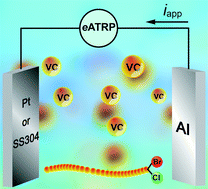Under pressure: electrochemically-mediated atom transfer radical polymerization of vinyl chloride†
Abstract
The stringent control over the polymerization of less activated monomers remains one major challenge for Reversible Deactivation Radical Polymerizations (RDRP), including Atom Transfer Radical Polymerization (ATRP). Electrochemically mediated ATRP (eATRP) of a gaseous monomer, vinyl chloride (VC), was successfully achieved for the first time using a stainless-steel 304 (SS304) electrochemical reactor equipped with a simplified electrochemical setup. Controlled polymerizations were confirmed by the good agreement between theoretical and measured molecular weights, as well as the relatively narrow molecular weight distributions. Preservation of chain-end fidelity was verified by chain extension experiments, yielding poly(vinyl chloride) (PVC) homopolymers, block and statistical copolymers. The possibility of synthesizing PVC by eATRP is a promising alternative to afford cleaner (co)polymers, with low catalyst concentration. The metal body of the reactor was also successfully used as a cathode. The setup proposed in this contribution opens an avenue for the polymerization of other gaseous monomers.



 Please wait while we load your content...
Please wait while we load your content...